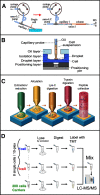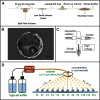Single-cell Proteomics: Progress and Prospects
- PMID: 32847821
- PMCID: PMC7664119
- DOI: 10.1074/mcp.R120.002234
Single-cell Proteomics: Progress and Prospects
Abstract
MS-based proteome profiling has become increasingly comprehensive and quantitative, yet a persistent shortcoming has been the relatively large samples required to achieve an in-depth measurement. Such bulk samples, typically comprising thousands of cells or more, provide a population average and obscure important cellular heterogeneity. Single-cell proteomics capabilities have the potential to transform biomedical research and enable understanding of biological systems with a new level of granularity. Recent advances in sample processing, separations and MS instrumentation now make it possible to quantify >1000 proteins from individual mammalian cells, a level of coverage that required an input of thousands of cells just a few years ago. This review discusses important factors and parameters that should be optimized across the workflow for single-cell and other low-input measurements. It also highlights recent developments that have advanced the field and opportunities for further development.
Keywords: Cell biology; Cell sorting; FAIMS; Label-free quantification; Mass Spectrometry; Tandem Mass Spectrometry; Tissues*; nanoLC; nanoPOTS; single-cell; ultrasensitive.
© 2020 Kelly.
Conflict of interest statement
Conflict of interest—Author declares no competing interests.
Figures



References
-
- Binnewies M., Roberts E. W., Kersten K., Chan V., Fearon D. F., Merad M., Coussens L. M., Gabrilovich D. I., Ostrand-Rosenberg S., Hedrick C. C., Vonderheide R. H., Pittet M. J., Jain R. K., Zou W. P., Howcroft T. K., Woodhouse E. C., Weinberg R. A., and Krummel M. F. (2018) Understanding the tumor immune microenvironment (TIME) for effective therapy. Nat. Med. 24, 541–550 - PMC - PubMed
Publication types
MeSH terms
Substances
Grants and funding
LinkOut - more resources
Full Text Sources
Other Literature Sources

